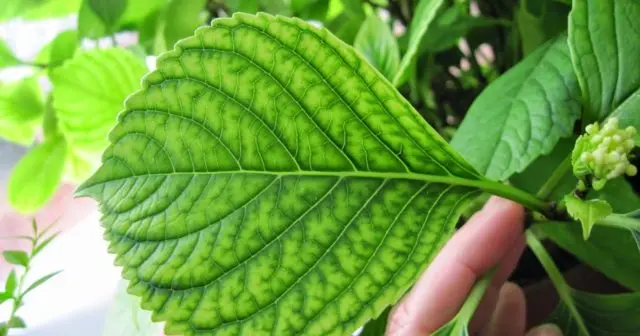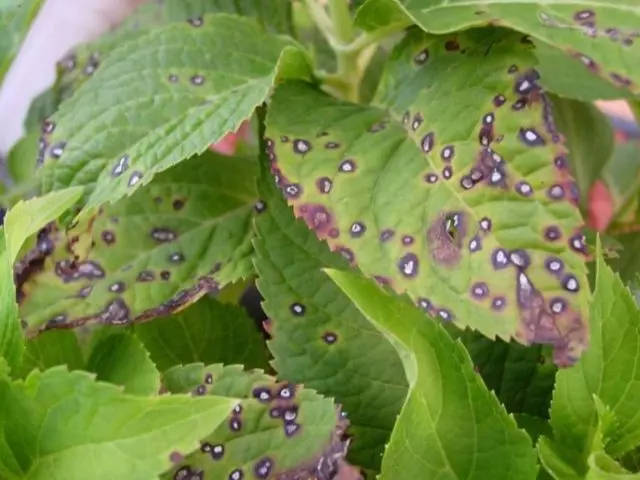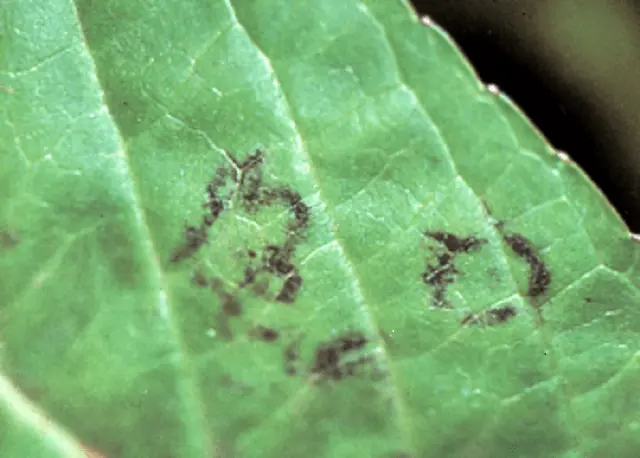Contents
Flowering plants are the decoration of any personal plot. Summer residents often break up entire flower beds with perennial and annual flowers. Hydrangea Bouquet Rose will not only decorate the site, but also fill the air with a pleasant, floral aroma.
Description Hydrangea Bouquet Rose
Acquaintance with hydrangea Bouquet Rose must begin with varietal characteristics. This is a large-leaved shrub, with timely formative pruning, it forms the shape of a ball up to 1,5 m high. The leaf plate is large, opposite, oblong in shape. The upper surface is rough, velvety, bright olive color.
Large spherical inflorescences, up to 30 cm in diameter, are painted in snow-white-pink, lilac, sky blue or purple. The color depends on the location of the bush and the acidity of the soil. Blue or pale pink flowering in large-leaved hydrangea bouquet rose occurs on soil with high acidity, lilac and beige flowers appear when growing on alkaline soil. Flowering is long and long.

The first buds appear at the ends of the shoots in June in the third year after planting and stay on the bush until the first frost.
During flowering, the shrub is covered with large, fragrant balls of delicate color. Therefore, this plant has gained popularity among flower growers. Seeing the first flowering, they acquire new varieties of hydrangeas and enjoy a long, beautiful vegetation for many years.
Hydrangea Bouquet Rose, like any garden plant, has positive and negative sides. The pluses include:
- long flowering;
- on one bush, flowers can be painted in different colors;
- large, spherical inflorescences;
- unpretentiousness in cultivation.
Disadvantages of the variety:
- for abundant flowering, growth and development, the bush must be watered abundantly;
- to acidify the soil, the soil is mulched with peat;
- average cold resistance;
- flowering on last year’s buds.
Hydrangea Bouquet Rose in landscape design
Hydrangea Bouquet Rose is widely used in the design of their summer cottage. With long flowering, shade tolerance, easy maintenance and rapid reproduction, it is indispensable in design planning. It will decorate the site in single plantings, next to other varieties of hydrangeas, barberries and perennial herbaceous plants.
Competently combine hydrangea with spruce crops. Since in the fall, after many plants have faded, the evergreen needles, combined with the blooming Bouquet Rose hydrangea, will delight the eye even in cloudy weather.
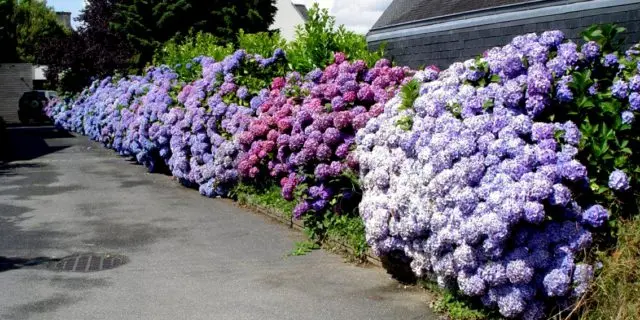
Hydrangea Bouquet Rose is suitable for creating a hedge, will be a wonderful backdrop for a flower garden
Winter hardiness hydrangea Bouquet Rose
Hydrangea Bouquet Rose does not have high winter hardiness. The shrub can withstand short frosts down to -18 ° C, otherwise the shoots and roots freeze out and are no longer restored. Therefore, in regions with warm winters, the hydrangea feels great outdoors, and in places with harsh winters, it needs shelter.
Planting and caring for hydrangea Bouquet Rose
In order for the plant to bloom, grow and develop well, it is important to know the rules of planting and care. They are not difficult, and even novice flower growers can handle them.
Selection and preparation of the landing site
When choosing a place for planting Bouquet Rose hydrangea, it is important to remember that the plant is thermophilic and prefers slight partial shade, where the open sun is only in the morning. When landing in an open place, the rays of the sun burn the foliage and lead to their drying out.
Hydrangea Bouquet Rose is planted on fertile acidified soil with good water and air permeability.
Rules of landing
The planting time of the hydrangea Bouquet Rose depends on the climatic conditions of cultivation. In the south of the country, it is planted in early spring or autumn, a month before the onset of cold weather. In order for the bush to grow, bloom and develop, you must follow the rules of planting:
- At the selected location, dig a hole according to the size of the root system.
- A layer of drainage is laid at the bottom (expanded clay, broken brick, pebbles).
- Next, fall asleep peat.
- The hole is poured with a bucket of water.
- After the soil settles, a seedling is installed with the root system straightened in the center.
- The plant is sprinkled with nutrient soil, tamping each layer so that there is no air space left.
- The top layer is mulched with peat and spilled abundantly.

In regions with an unstable climate, seedlings are taken out into the ground only in spring, after the soil warms up and spring frosts end.
Watering and top dressing
Hydrangea Bouquet Rose does not tolerate dry soil. Therefore, watering is carried out once a week, and in dry, hot summers, irrigation is done once every 3 days. Watering is necessary strictly under the root, otherwise drops of water that fall on the inflorescences lead to the appearance of dark spots, as a result, the plant loses its decorative appearance.
Plant nutrition is needed for long flowering. Hydrangea Bouquet Rose is fed with a mineral fertilizer complex. For blue and purple blooms, potassium should predominate in fertilizers. Top dressing is applied 3 times a season:
- in the spring at the beginning of active growth;
- in summer during the formation of buds;
- autumn during the laying of flower buds.
Pruning hydrangea large-leaved Bouquet Rose
Hydrangea Bouquet Rose blooms on last year’s shoots, so the bush does not need pruning for the winter. Also, experts do not recommend pruning faded inflorescences. It is better to do this procedure in the spring, since during the cold weather they will be able to save flower and vegetative buds from severe frosts.
Preparation for winter
Large-leaved hydrangea Bouquet Rose is not resistant to extreme cold, so it is better to cover the bush for the winter. For this:
- After flowering, a bucket of peat is poured under the bush.
- The branches are twisted and wrapped with agrofibre.
- Burlap is put on top, which is fixed to the ground with bricks.
Reproduction
Hydrangea Bouquet Rose is propagated in 3 ways: seeds, cuttings and taps.
Cutting carried out after pruning. Prepared shoots are divided into cuttings 10-15 cm long. Planting material with 2 internodes is kept in a root former and planted at an acute angle in a cup with nutrient soil. For better rooting, the container is covered with a glass jar and cleaned in a warm place. A rooted cutting is planted in a new area in the spring after the end of frost.
Seed Reproduction the occupation is difficult and not suitable for beginner gardeners. To propagate hydrangea seeds, planting material is sown in separate containers with nutrient soil and removed to the warmest place. Care of seedlings consists in timely watering and picking after the appearance of 3-4 true leaves. Young seedlings are planted in open ground for 3 years after sowing seeds.
Reproduction by taps – the easiest and most effective way of reproduction. To do this, choose a healthy shoot, which is located near the ground, and placed in a prepared trench, leaving the top above the ground. To accelerate root formation on the shoot, a circular incision is made and treated with a growth stimulator. After the plant builds up a powerful root system, it is separated from the mother bush and transplanted to a new place.
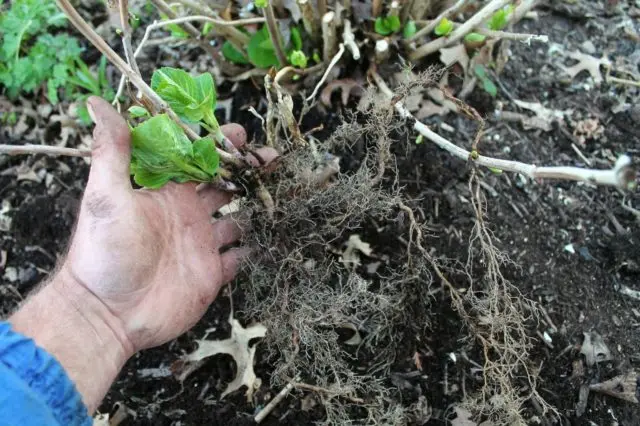
Rooted branch transplanted in the spring
Diseases and pests
Hydrangea Bouquet Rose rarely gets sick and is almost never attacked by insect pests. But if the agrotechnical rules are not followed, problems can be encountered:
- Foliage dries – occurs when growing in the open sun and lack of moisture.
- The leaf plate turns yellow – a lack of a mineral complex of fertilizers.
- Lack of inflorescences – flower buds freeze out in winter.
The following diseases can also appear on the plant:
- Chlorosis. Appears due to metabolic disorders and lack of iron in the soil. If you do not start treatment, the plant will weaken, lose its decorative appearance, and flowering will stop. For prevention, iron-containing preparations are introduced into the soil; irrigation can only be carried out with settled water.

When infected, the leaf plate brightens, and the veins remain dark
- Gray rot. Dangerous fungal disease. When infected, the ground part becomes watery, dark spots appear on the foliage and stem, which dry out and fall out in dry weather. The cure is to remove the affected areas.

The fungus spreads quickly in wet weather.
- Ring spot. A viral disease that leads to the death of the plant. You can recognize it by the spots in the form of a ring. With a strong infection, the bush stops growing and developing.

The leaf plate becomes wrinkled and asymmetric
In order not to run into problems, it is important to observe agricultural technology. When all the recommendations are followed, the shrub will show itself in all its glory and will become an adornment of the backyard for many years.
Conclusion
Hydrangea Bouquet Rose is a flowering, perennial shrub. By choosing the right place and carrying out timely care, you can get spherical inflorescences of blue, pink and purple flowers. Large-leaved hydrangea looks great in single plantings and next to perennial shrubs.










